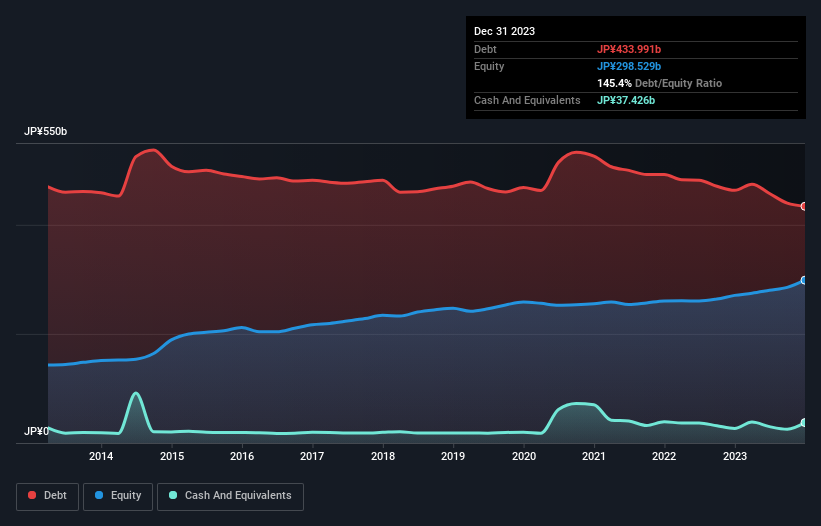
Howard Marks put it nicely when he said that, rather than worrying about share price volatility, 'The possibility of permanent loss is the risk I worry about... and every practical investor I know worries about.' It's only natural to consider a company's balance sheet when you examine how risky it is, since debt is often involved when a business collapses. As with many other companies Nankai Electric Railway Co., Ltd. (TSE:9044) makes use of debt. But is this debt a concern to shareholders?
When Is Debt Dangerous?
Debt assists a business until the business has trouble paying it off, either with new capital or with free cash flow. If things get really bad, the lenders can take control of the business. While that is not too common, we often do see indebted companies permanently diluting shareholders because lenders force them to raise capital at a distressed price. Of course, debt can be an important tool in businesses, particularly capital heavy businesses. When we examine debt levels, we first consider both cash and debt levels, together.
Check out our latest analysis for Nankai Electric Railway
How Much Debt Does Nankai Electric Railway Carry?
As you can see below, Nankai Electric Railway had JP¥434.0b of debt at December 2023, down from JP¥463.2b a year prior. However, it also had JP¥37.4b in cash, and so its net debt is JP¥396.6b.

A Look At Nankai Electric Railway's Liabilities
According to the last reported balance sheet, Nankai Electric Railway had liabilities of JP¥175.1b due within 12 months, and liabilities of JP¥452.3b due beyond 12 months. Offsetting these obligations, it had cash of JP¥37.4b as well as receivables valued at JP¥23.1b due within 12 months. So it has liabilities totalling JP¥566.8b more than its cash and near-term receivables, combined.
This deficit casts a shadow over the JP¥361.7b company, like a colossus towering over mere mortals. So we'd watch its balance sheet closely, without a doubt. After all, Nankai Electric Railway would likely require a major re-capitalisation if it had to pay its creditors today.
We use two main ratios to inform us about debt levels relative to earnings. The first is net debt divided by earnings before interest, tax, depreciation, and amortization (EBITDA), while the second is how many times its earnings before interest and tax (EBIT) covers its interest expense (or its interest cover, for short). The advantage of this approach is that we take into account both the absolute quantum of debt (with net debt to EBITDA) and the actual interest expenses associated with that debt (with its interest cover ratio).
As it happens Nankai Electric Railway has a fairly concerning net debt to EBITDA ratio of 6.7 but very strong interest coverage of 14.9. So either it has access to very cheap long term debt or that interest expense is going to grow! It is well worth noting that Nankai Electric Railway's EBIT shot up like bamboo after rain, gaining 75% in the last twelve months. That'll make it easier to manage its debt. When analysing debt levels, the balance sheet is the obvious place to start. But it is future earnings, more than anything, that will determine Nankai Electric Railway's ability to maintain a healthy balance sheet going forward. So if you want to see what the professionals think, you might find this free report on analyst profit forecasts to be interesting.
Finally, a company can only pay off debt with cold hard cash, not accounting profits. So it's worth checking how much of that EBIT is backed by free cash flow. During the last three years, Nankai Electric Railway produced sturdy free cash flow equating to 58% of its EBIT, about what we'd expect. This cold hard cash means it can reduce its debt when it wants to.
Our View
While Nankai Electric Railway's net debt to EBITDA has us nervous. To wit both its interest cover and EBIT growth rate were encouraging signs. When we consider all the factors discussed, it seems to us that Nankai Electric Railway is taking some risks with its use of debt. So while that leverage does boost returns on equity, we wouldn't really want to see it increase from here. There's no doubt that we learn most about debt from the balance sheet. However, not all investment risk resides within the balance sheet - far from it. We've identified 2 warning signs with Nankai Electric Railway , and understanding them should be part of your investment process.
At the end of the day, it's often better to focus on companies that are free from net debt. You can access our special list of such companies (all with a track record of profit growth). It's free.
Valuation is complex, but we're here to simplify it.
Discover if Nankai Electric Railway might be undervalued or overvalued with our detailed analysis, featuring fair value estimates, potential risks, dividends, insider trades, and its financial condition.
Access Free AnalysisHave feedback on this article? Concerned about the content? Get in touch with us directly. Alternatively, email editorial-team (at) simplywallst.com.
This article by Simply Wall St is general in nature. We provide commentary based on historical data and analyst forecasts only using an unbiased methodology and our articles are not intended to be financial advice. It does not constitute a recommendation to buy or sell any stock, and does not take account of your objectives, or your financial situation. We aim to bring you long-term focused analysis driven by fundamental data. Note that our analysis may not factor in the latest price-sensitive company announcements or qualitative material. Simply Wall St has no position in any stocks mentioned.
About TSE:9044
Second-rate dividend payer with questionable track record.
Market Insights
Community Narratives



